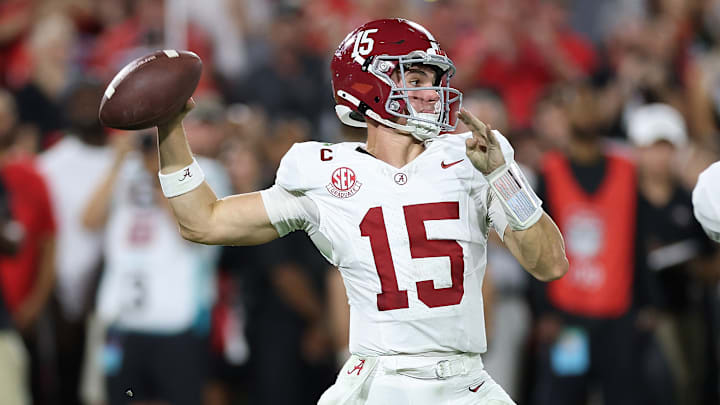In early 2021, Clemson made Ty Simpson its top quarterback priority. When Simpson committed to Alabama, the Tigers moved quickly on Cade Klubnik, the polished Austin (Westlake) passer with a winner’s résumé and advanced timing traits. It was a classic sliding-doors moment: the same class, two elite prospects, two very different ecosystems.
Simpson matured inside a quarterback-centric infrastructure—first under Nick Saban’s process, then in a Kalen DeBoer offense built on motion, spacing, layered route concepts and clean answers versus pressure. The result: a passer operating on rhythm, attacking the middle of the field with confidence, and getting manufactured explosives off play design as much as individual heroics. When your reads are defined and your vertical shots are schemed, efficiency follows.
This week, FOX’s Joel Klatt raved that if Simpson’s last name were “Manning,” we’d “cancel the Heisman ceremony and just do it now,” calling Alabama’s attack the best pure passing game in college football and praising multiple “top-three draft pick” throws on Simpson’s film. Books reflect the surge: Simpson is sitting in that +800 to +1000 tier among the favorites, and his production backs it up—1,478 passing yards, 13 TDs, just 1 INT, and a 70.3% completion rate after a 23-of-31, 340-yard, 2-TD day in a 30–14 win over Vanderbilt.
Klubnik arrived with big-game skins and immediately flashed poise. He’s piled up production, delivered championship moments, and—at his best—looks like the distributor Clemson envisioned. But the Tigers’ offensive identity since 2022 has wobbled in two places that magnify any QB’s flaws: finishing drives (red-zone touchdown rate) and creating explosives (true 40–50+ yard shots). When the scheme doesn’t hand you cheap explosives, every throw feels like third-and-seven.
This was never about “whiffing” on talent. Clemson landed a blue-chip quarterback good enough to win at the highest level. Alabama did too. The separating factor in 2025 is ecosystem:
Alabama asks its QB to be a point guard in a playbook that manufactures leverage and speed in space.
Clemson has often asked its QB to be the offense while the structure searches for a ceiling.
Where it goes from here
For Clemson, the path forward is clear: Reclaim explosives through motion, bunch, and shot sequencing on first down; sharpen red-zone identity (tight splits, condensed sets, QB run tags); protect the quarterback with tempo pockets and RPO answers on early downs.
Do those things and the “what if we’d landed Simpson?” barstool debate fades. Klubnik has already shown the baseline; a cleaner framework unlocks the rest.
Bottom line
Clemson didn’t lose a quarterback; it lost a path. Alabama placed Ty Simpson on a runway built for takeoff. Clemson handed Cade Klubnik the yoke while still paving the runway. The recruiting decision set the cast; the systems wrote the script.
